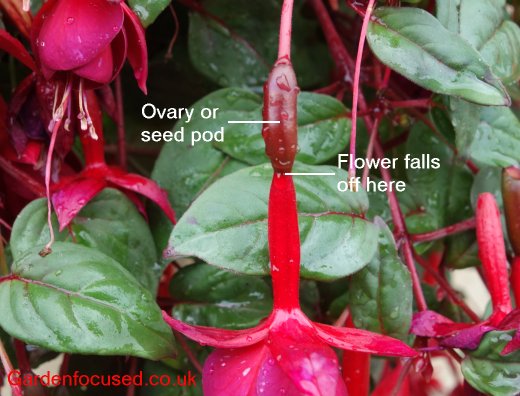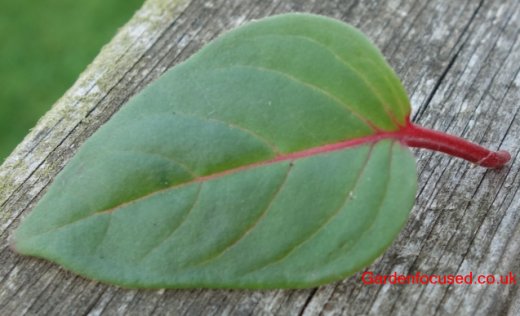MARINKA FUCHSIAS
Article by David Marks
Trailing fuchias are the kings of hanging baskets. They drip down over the edges of a hanging basket completely hiding it and prduce flowers from late June until late October. The also make excellent plants for containers. They will grow in open ground, however their trailing habit is not suited to this.

![]()
Fuchsia Marinka in hanging basket
Marrinka is one of the very best of the trailing fuschia varieties producing a large number of single, deep red flowers and attractive foliage. The one pictured above is growing in my garden on the house wall.
KEY FACTS FUCHSIA ‘MARINKA’
| Height | 50cm (plis trailing stems / flowers) |
| Spread | 60cm |
| Soil | In a container or hanging basket, use multipurpose compost |
| ph | Acid, alkaline and neutral |
| Flowers | June to mid autumn, lots of red flowers |
| Foliage | Attractive mid green withred veins |
| Hardy | Down to 0C / 32F |
| Evergreen | No |
| Position | Partial shade, avoid windy areas. Will tolerate full sun |
| Easy Care | Yes, feed and water regularly. Remove faded flowers and seed pods |
| Small gardens | Yes |
| Support / staking | No, this is not required |
| Containers | Yes, excellent choice for hanging baskets and containers |
| RHS AGM | Yes |
HOW TO PLANT FUCHSIA ‘MARINKA’
If the basket is to be planted entirely with Marinka fuschias, then three plants to a 14 inch basket works very well. Only plant up when all danger of frost has passed. If you are planting a mixed hanging basket, use one Marinka fuchsia and allow one third of the basket for the fuschia.
Line the basket with a 14 inch hanging basket liner which is in good condition. The size and condition of the liner are important for ease of watering throughout the season.
Fill the basket with general purpose compost to within 2cm / 1in from the top. Don’t fill completely to the top, this will allow water to soak into the compost rather than run off the top of it.
Use your fingers to make three equally spaced holes in the compost large enough to place the the potted plants in, to roughly the same level as they were in their pots. Place the plant rootballs in the holes and gently firm the soil in around the plants. Water the basket well but initially there is no need to feed – that can start in two to three weeks time.
For the last two years we have used Squire’s garden centre own brand peat free compost. For us it has worked far better compared to other peat free composts. In Which magazine trials during 2021, their winner for containers was was Homebase own brand peat free compost.
The best site or position for a fuchsia hanging basket or container (Marinka included) is in sun during the morning and light shade from midday onwards. They will grow in full sun but are not at their best in this position. Bear this in mind if you are considering planting a hanging basket / container with other plants.
HOW TO CARE FOR FUCHSIA ‘MARINKA’
The two most important care taks for all fuchsias (in order of importance) are watering and feeding. The third care need is to remove the ovaries / seed pods when the flowers have fallen off, this called dead-heading.
WATERING
Fuchsias in hanging baskets especially will require watering most days, and in warm weather sometimes twice a day. If in doubt, water them at least once a day. I use tap water and that seems fine for the plants.
The reason I say “if in doubt ….” is that if a fuchsia hanging basket dries out when the plant is fully developed it is very difficult to get the compost wet again, water simply runs off the sompost surface without wetting the compost below.
When the plants are in the first month after planting it’s probably possible to water them every second day. But soon after that, daily watering is probably required.
When the plants fully fill the basket it is very difficult to judge how dry or wet the compost is. One trick I use is, each time I fully water the hanging basket, I put my hand under the base of the basket and slightly lift it. If you do this a few times you will soon be able to judge from the weight in your hand if the compost is moist or not.
Remember, even heavy rain will contribute very little to the water requirement of a hanging basket. Frequently, hanging baskets are sited on a house wall and the overhanging eaves prevent much water from reaching the baket. What little does, will most likely simply fall onto the foliage which then sheds it off their suface away from the compost.
FEEDING
Without a doubt liquid tomato feeds are best for feeding fuchsias in hanging baskets and containers. Tomato feed is formulated to have a higher than avaerage amount of potassium in it which promotes better and more flowers.
There are three key elements to any plant feed; nitrogen (N), phosphorous (P) and potassium (K). If you look at the make up of a standard all purpose feed such as Miracle Gro, it has an NPK ratio of 7:3:5, in other words it is a high nitrogen feed. Nitrogen promotes leaf growth. It has a medium amount of potasium in it.
If you look at the make up of Levingtons Tomorite, it has an NPK ratio of 4:3:8, in other words it is a high potassium feed , just what fuschias like Marinka want.
As long as the compost used for the hanging basket is new all purpose compost then it will contain sufficient feed for the first three weeks so there is no need to feed it initially. After three weeks feed the basket once a week at the strength shown on the pack. mid July onwards, fee every three to four days.
DEAD HEADING
When a fuschia flower dies it falls off the plant. It leaves behing the stalk and an ovary, sometimes called the seed pod. See the picture below.

![]()
The purpose behind the ovary is for the fuchsia to produce seeds and that takes energy away from growing more flowers. When the plant is in flower, each time you water it look for the ovaries without any flower and pinch them off. It’s also a good idea to look for dead flowers that have fallen onto the plant rather than the ground. If left in or on the foliage they will decay and be a source of fungal diseases.
PESTS AND DISEASES
The most common problem with Marinka is likely to be fuschia rust. The leaves will have a “rusty appearance” to them. This problem and the others mentioned below are described in detail on our fuchsia pest and disease page here.
Aphids can also be a problem, however under good conditions the plants will shrug off an aphid attack.
Probably the most serious problem for fuschias is Fuschia Gall Mite. It’s not the most common problem but if you fuschia is affected, you will end up with distorted foliage which will ruin your fuchsia. There is no treatment.
Although it rarely affects fuschias in baskets, Vine Weevil is relatively common if fuchsias are grown in containers. Although treatable, in most cases the damage will have been done by the time you realise you have a problem.
WHERE TO BUY FUCHSIA ‘MARINKA’
I don’t know when Marinka was first released but I do know that I won first prize with my hanging basket of Marinka at my local horticultural show some 30 years ago. So this fuchsia variety goes back many years. It is very popular and is sold at most garden centres and is readily available online.

